QolorTOPIX Podcast Episode 6: Left on Tenth
This QolorTOPIX episode features Itohan Edoloyi and Ken Billington, the lighting designers for the new play Left on Tenth.
Listen to the podcast episode below or wherever you listen to podcasts.
QolorTOPIX Light Conversation with Itohan Edoloyi and Ken Billington,
Co-Lighting Designers for new Broadway play, Left on Tenth
Hello! Welcome to Episode 6 of the QolorTOPIX Light Conversations podcast series.
Published in October 2024, our sixth episode features lighting designers Itohan Edoloyi and Ken Billington, who worked together as the lighting team behind the new Broadway play, Left on Tenth, written by Delia Ephron.
This episode was hosted by Jackie Morreale from the City Theatrical Marketing Team.
Other QolorTOPIX episodes include:
LISTEN NOW!
About the Guests:
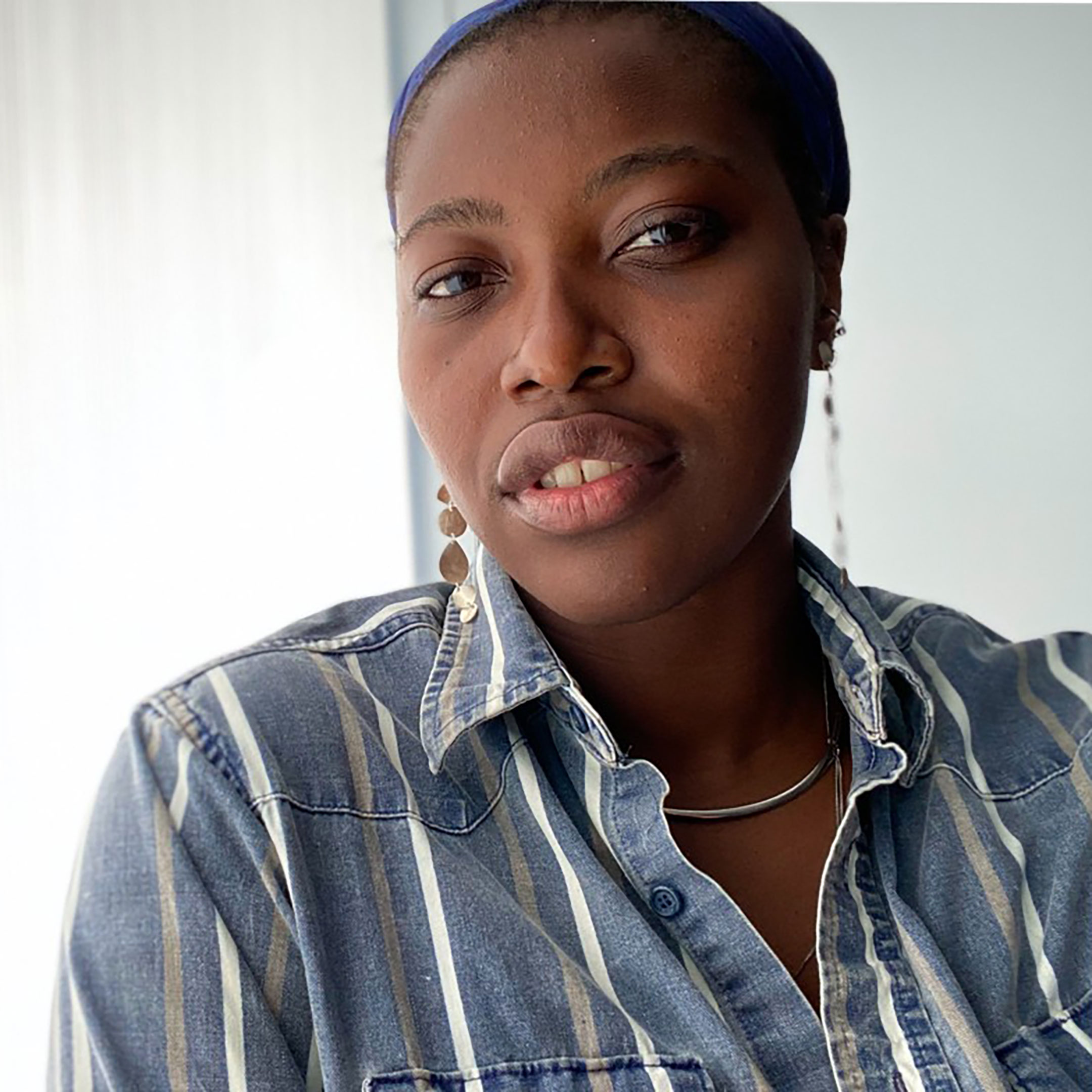
Itohan Edoloyi
Itohan Edoloyi is a lighting designer and artist whose work is rooted in community and culture. Her work aims to continue storytelling in non-traditional ways, crafting meaningful experiences through the lens of light and immersion. Itohan has designed for theatre, dance, music performances and installations. She has worked nationally and internationally at venues such as: Lincoln Center, The Shed, Little Island, Joyce Theater, Transit Festival in Belgium, Espace Libre, Guggenheim Museum, The Momentary, Conjunto Santander de Artes Escénicas, REDCAT, Walker Arts Center and more. Itohan has co-curated The Social Sculpture Project at Lincoln Center and is the curator for InLight Collective. She also associate designed Trouble in Mind (Broadway) & We’re Gonna Die (Second Stage). Itohan has been awarded the Lilly Award and the Gilbert V. Hemsley Lighting Award.
Read more about Itohan Edoloyi at: itohanedoloyi.com
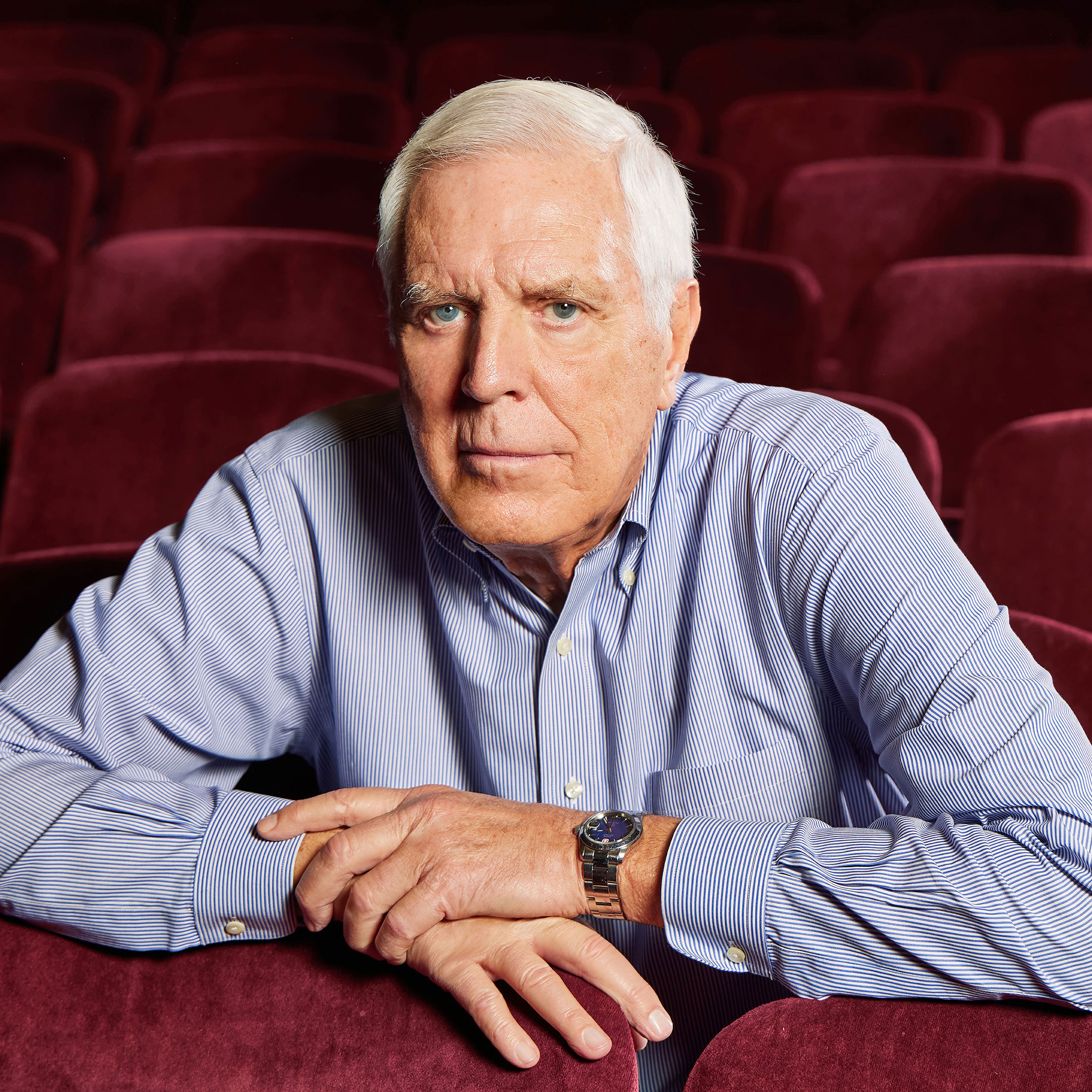
Ken Billington
Ken Billington creates lighting for the theatre, television and architecture. Among his over 100 Broadway shows are the original production of Sweeney Todd, the current Chicago, the longest-running American musical in history, Waitress, Act One, Hugh Jackman Back on Broadway, The Scottsboro Boys, White Christmas, Title of Show, Footloose, as well as revivals of My Fair Lady, Hello Dolly, Sunday in the Park… (twice), Annie (twice), and Fiddler on the Roof (three times). Ken has lit such spectaculars as the Christmas Show at The Radio City Music Hall and Fantasmic at Disneyland. Architecture includes New York’s Tavern on the Green and 54 Below. Ken’s awards include the Tony, the Lumen (architecture), and the Ace (television). In 2015, Ken Billington was inducted into the Theatre Hall of Fame.
Read more about Ken Billington at: kenbillington.com
PODCAST TRANSCRIPT:
City Theatrical (CT): Hello and welcome to QolorTOPIX, City Theatrical’s podcast series. Today, we are joined by Itohan Edoloyi, who recently made her Broadway debut as lighting designer, and Ken Billington, who has designed over 100 Broadway shows during his career in lighting. Together, they are lighting designers behind the new Broadway play Left on Tenth, by Delia Ephron. Let's kick off our conversation with some Q&A.
Itohan, can you please share with us: How did you get started in lighting?
00:36
Itohan EdoIoyi (IE): I started in college a little bit later in the game than other people. Just to preface, I was in the theater realm as a kid. I grew up in New York City. I'm a New York native. My mom used to take my brother and me to the New Victory Theater to see shows. I never made the connection that it would be something that I would do professionally.
I went to school to study to be a pharmacist, but I was like, this doesn't feel right. I was really good at math and science, but something in me was like, this doesn't feel right for me in the future. Young Itohan.
I went to school initially to do sound engineering. I always was fascinated with music and sound. So, I was like, I'm just going to do sound engineering. At the college I went to, we just take courses in scenic technology, lighting, video, sound, that sort of a thing. In my lighting technology course, my professor, I think he's retired now, Chip Charles Scott, had a lesson one day about color theory. We started having LED units at the time in our school, and they were changing the color of the LED light. That would then change the color of the lights that were on this plywood board, and I was blown away. I was like, you can manipulate people's perception just by changing color? That was it. Forget about sound. I finished it up just, you know, because I'm not a quitter. But I moved into lighting from that and I've been following lighting ever since.
CT: Thank you.
Ken, how did you get started in lighting?
02:01
Ken Billington (KB): I turned the lights on and off for the 4th grade play. I thought it was cool and that's what I wanted to do, and I'm still doing it, actually. I've known since however old you are in the 4th grade - is that nine? Maybe 10? I knew then that I wanted to do lighting. I didn't know the word “designer” in those days, but all I wanted to do was lighting and I did it all through high school and community players. I didn't go to college. I got out of high school and started assisting on Broadway. Who knows why, but I did. Did that for a few years and then started lighting shows. And people still hire me, and I guess I know what I'm doing so. Woohoo.
CT: It seems that way, after hundreds of Broadway shows, huh?
2:54
Ken, do you remember your first City Theatrical lighting accessory? What was it, and how did you use it?
The first one was back in the early 1980s when Gary Fails literally just started the company [City Theatrical]. We did lots of architectural lighting and it was MR16 for days in that era and there were never any top hats for MR16s. Nobody made them, so I called Gary, and he made Top Hats for me. Little tiny Top Hats for MR16s. That has to be 1983 or 1984.
CT: We’re still making Top Hats today, almost 40 years later.
Itohan, what is your first experience with City Theatrical accessories?
03:31
IE: I used to be an electrician many years ago for corporate events. We would always have some City Theatrical accessories for that. As corporate events go, we used a lot of wireless DMX setups with uplights and everything that was outside of them. I just remember those days, setting up the SHoW Baby outside and then a SHoW Baby next to the console, and then we would sort of go back and forth.
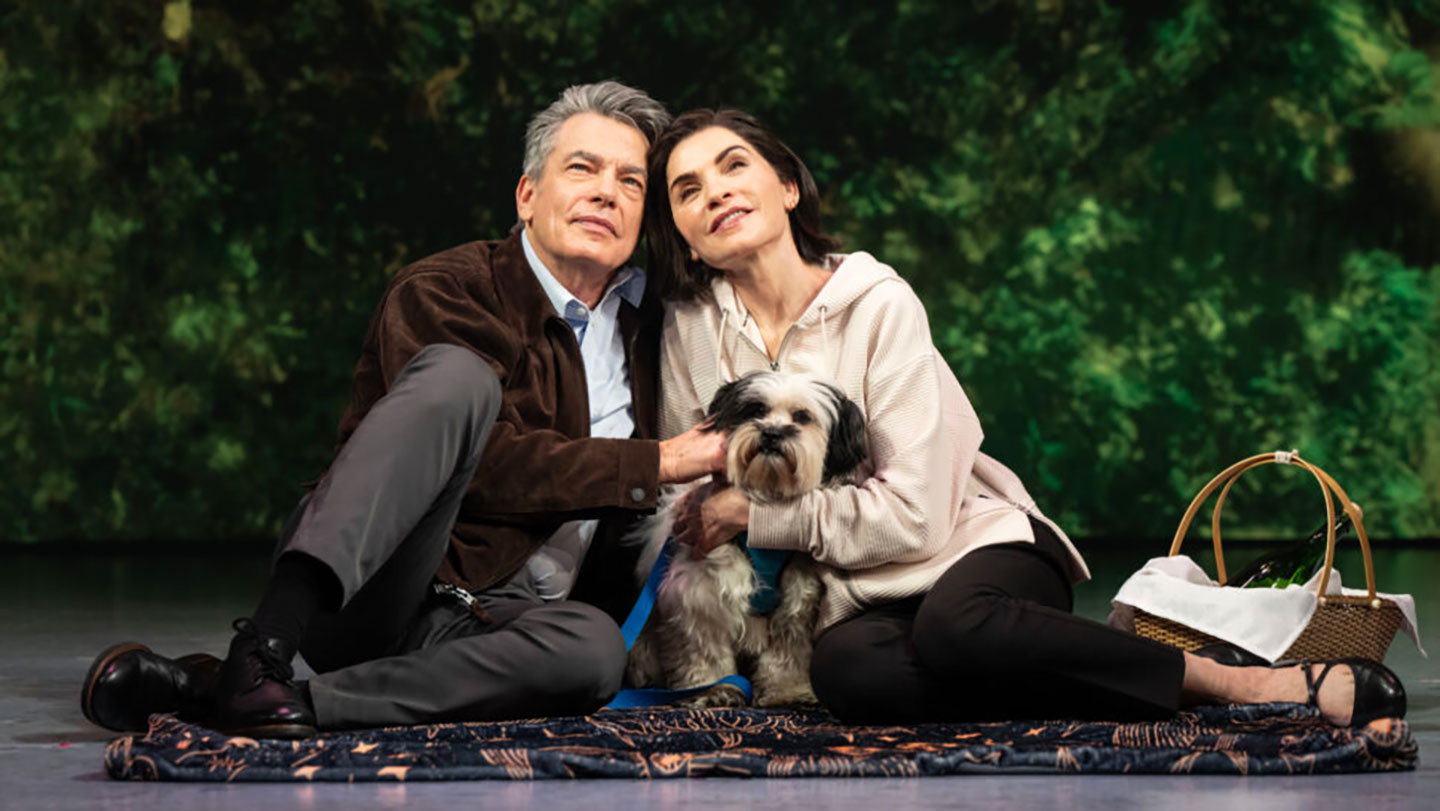
Peter Gallagher and Julianna Margulies in Left on Tenth (Joan Marcus)
CT: We're still making Multiverse SHoW Babies, so absolutely! Wireless DMX is our thing.
Let's continue with Itohan: What has been your favorite show or project to work on?
03:31
IE: As of recently, I worked on a project with set designer Mimi Lien. I sort of have leaned into design for installation work. I've been introducing more installation work to myself and then in this project that I did with Mimi Lien. I think it started in 2021. Mimi asked me to be a part of something called The Social Sculpture Project that she was invited to, as part of seven cohorts that Lincoln Center had hired to sort of showcase work. Mimi and I knew each other during the time when I was a part of this group, called DESIGN ACTION. Through them, she said, I hear you're interested in installation work, do you want to be a part of this with me? She and I co-curated The Social Sculpture Project, which brought 10 emerging artists, some of them very good friends of mine or friends of mine that I have had conversations whilst in the theater realm, talking about their interest in installation work. So I sort of chucked it in the back of my mind, but in essence, we then brought 10 emerging, new establishing artists to Lincoln Center to then create and install work of art that's sort of close to them. It was an opportunity to showcase artists that aren't often given the opportunities, or known to then give the opportunities to show works. Things like that where I'm uplifting the community or uplifting people that I know… I feel like that's my favorite thing to do, and installation is great.
CT: And right at Lincoln Center that that sounds like a beautiful project.
IE: Yes, it was really gorgeous. We just finished it this year. So, it was a big end!
CT: Three-year long project sounds amazing.
Ken, what has been your favorite project or show to work on?
06:05
KB: My favorite project is the one I'm working on. So many shows, you know. With over 100 on Broadway, that many off Broadway now and in the operas, and then the tours in the UK and International, and it does goes on.
Probably the things that I enjoyed the most are the ones where I had the best time. Was it the prettiest to look at? I don't know, but it was fun to be in the room.
What show am I working on today? So today, I'm working on Smash, the new Broadway musical for the Spring. So that's my favorite show this week.
CT: Very good. I like that. I can't wait to see it, by the way.
KB: Yeah, me too.
CT: While we're on the topic of Broadway, let's talk more about Left on Tenth. You are both the lighting designers for this new play. Can you start by telling us how you started working together on this project?
06:59
KB: I was offered this show, and I thought, wait a minute. I got lots of credits. I'm sort of an established guy. I said, I want to help somebody who was a brilliant young designer, to get a show on Broadway. It helps the resume, it helps a lot of things - confidence and everything. How to work in Midtown and Broadway – it is just a unique work environment. You're dealing with so many different things with personalities and unions and budgets and whatever.
Then I thought of Ito. I loved her since I met her, I don't know, six years ago? How many years ago, maybe even eight? I don't know.
I thought she was a great artist and personable. Everything was right about her. I asked her to join us on Left on Tenth, and the director Susan Stroman was 100% behind it, as was Daryl Roth, the producer. So, we just did it together, and I'm thrilled that we did. It was a real collaboration. That was the fun part.
08:11
IE: It was! Like Ken said, it was a fun experience. It's nice to just be a different person in that room. I have worked on Broadway before. The first play that I worked on as an associate lighting designer was Trouble in Mind with Kathy A. Perkins as the lighting designer. It was good learning grounds, actually to just interact with the crew, interact with the director, and the whole design team. To learn and get the hands on experience of doing and learning and processing and navigating the space and your ideas versus another person's ideas, like Ken’s ideas, and us finding the balance on that, which I think we really did find. That felt good to me.
KB: Yes, it was an equal partnership from the director, from the designer, from the crew. If Ito wasn’t there, it was, Hey, Ken. If I wasn't there, it was, Hey, Ito. It was team lighting! It was great.
CT: Itohan, how did it feel to make your Broadway debut with this show?
09:18
IE: It's mental. I don't know if I've actually fully processed everything now that I'm working on another show as well - there's not much time for processing. I feel really grateful and humble to have Ken give me the opportunity, to be a younger person in the room.
Also, it feels insane because I'm the third black woman ever lighting-wise to design on Broadway. The second one was Kathy Perkins, whom I had worked with as her associate in 2021, when Trouble in Mind opened on Broadway. There's an incredible weight to that, that I just feel really honored and humbled by the whole experience. I feel it’s something I'm processing, but I'm still very grateful.
CT: Congratulations - major accomplishment, breaking barriers, all of all of the wonderful things that come with the Broadway debut, plus! Congratulations on your wonderful accomplishment.
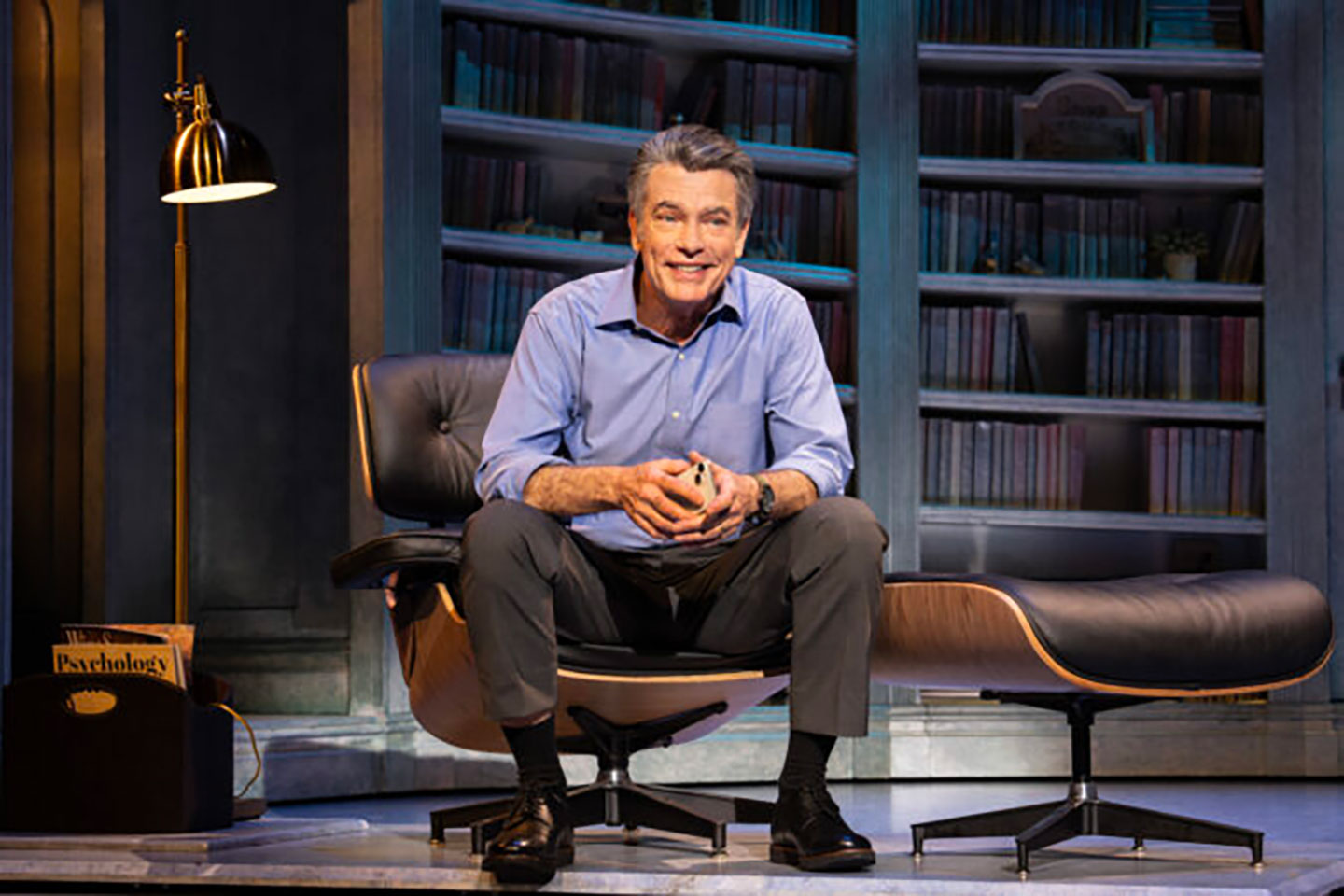
Peter Gallagher in Left on Tenth (Joan Marcus)
CT: Ken, what makes this play special to you?
10:22
KB: What makes this play special? It's the personalities. Delia Ephron, who wrote the book, which the play is based on, is this amazing woman who has been through such adverse stuff and come out as this cheery, lovely, happy person.
Susan Stroman called me and said, are you interested? And I read the book. I didn't read the play, I read the book, and I thought, oh, this is good. This is something.
The play is an hour and 41 minutes. It starts as a comedy, it gets very serious, and it has a joyous end. The audience really likes it.
I've done a lot of shows. When you sit in the back of the theater in the last row during previews of a show, you've now watched however many times. For Left on Tenth, the audience never moved their heads. They would sit down, the curtain would go up, Julianna Margulies makes her entrance, they would applaud. And then I thought it was a wax works in front of me because there was no crunching around and leaning over. During the entire preview period, I saw three people scoot to the toilet. Never did I see anybody walk out.
They listened and they watched. It wasn't like, hey, Tuesday night they listened and watched, and Wednesday afternoon, they didn't do anything. It was consistent every performance. What that told me was that they were listening. They were enjoying it, and they were being moved by it. That, of course, makes what we do - putting together a project with all the departments - thrilling. It was just nice to be there and to see that the audience was liking it. We all watched four weeks of previews, which was a very long time, and it was consistent at every show, which makes me know we all did something right.
CT: Absolutely. Delia Ephron, the writer of the play and novelist also known for You've Got Mail among others. She writes these beautiful stories. This play was her memoir. You just described her as such a beautiful person, and such a beautiful story that she shared.
Any thoughts that you have in terms of working with her on it, or with Susan Stroman? In terms of how the story might have affected your lighting design or process?
13:00
KB: Having done many Stroman projects, I know the process and I know how that is going to work. Ito might be able to tell you a little because it was the first time for her, working with Susan Stroman.
Delia Ephron was so open. I just go plop down in the seat next to her and chat with her. Some authors you don't want to do that with. Her husband Peter was always there with her for performances. She was totally open - she'd tell you anything. When I said, Why did you behave like this? What was going on? She would gladly tell me what was happening when she was lying in the hospital bed. And that was really interesting.
It was just open. Nobody was hiding anything. That's the best. There was no whispering in the corners. Everything was just right out front. Everything was done in a collaborative form, which is wonderful.
Ito was new to this Stroman process. She may have a different point of view.
14:05
IE: I agree with what you said, Ken, and I also feel that everyone's level of detail and attention was just perfect when we got into rehearsals. Just to see what they were working on in the run-throughs and how similar and on point Susan Stroman and the directorial team were on all of these fine and minute points. It made it flow that much smoother because we're working, and we are spacing it already, given everything has worked out.
She's like, oh, we can change it based upon the actors’ comfort level then, then it’s changed. I was just fascinated about the level of detail that was put in, not only just from the directorial team, not only with Delia, but also the entire creative team as a whole.
The process itself was nice because we were a full team. Like Ken said, there wasn't a moment where we were whispering or doing something behind each other’s back. We were just one unit moving towards this idea and it was beautiful to see.
Delia was there every day with us. For the performances, her and Peter are there watching it every day. I caught myself one performance, where I was sitting kind of next to them, just watching them watch their story unfold to see certain instances of things that still affected them, things that that they cherish.
The whole process was just very succinct, really. I took great joy and pleasure working on it and being a part of that team.
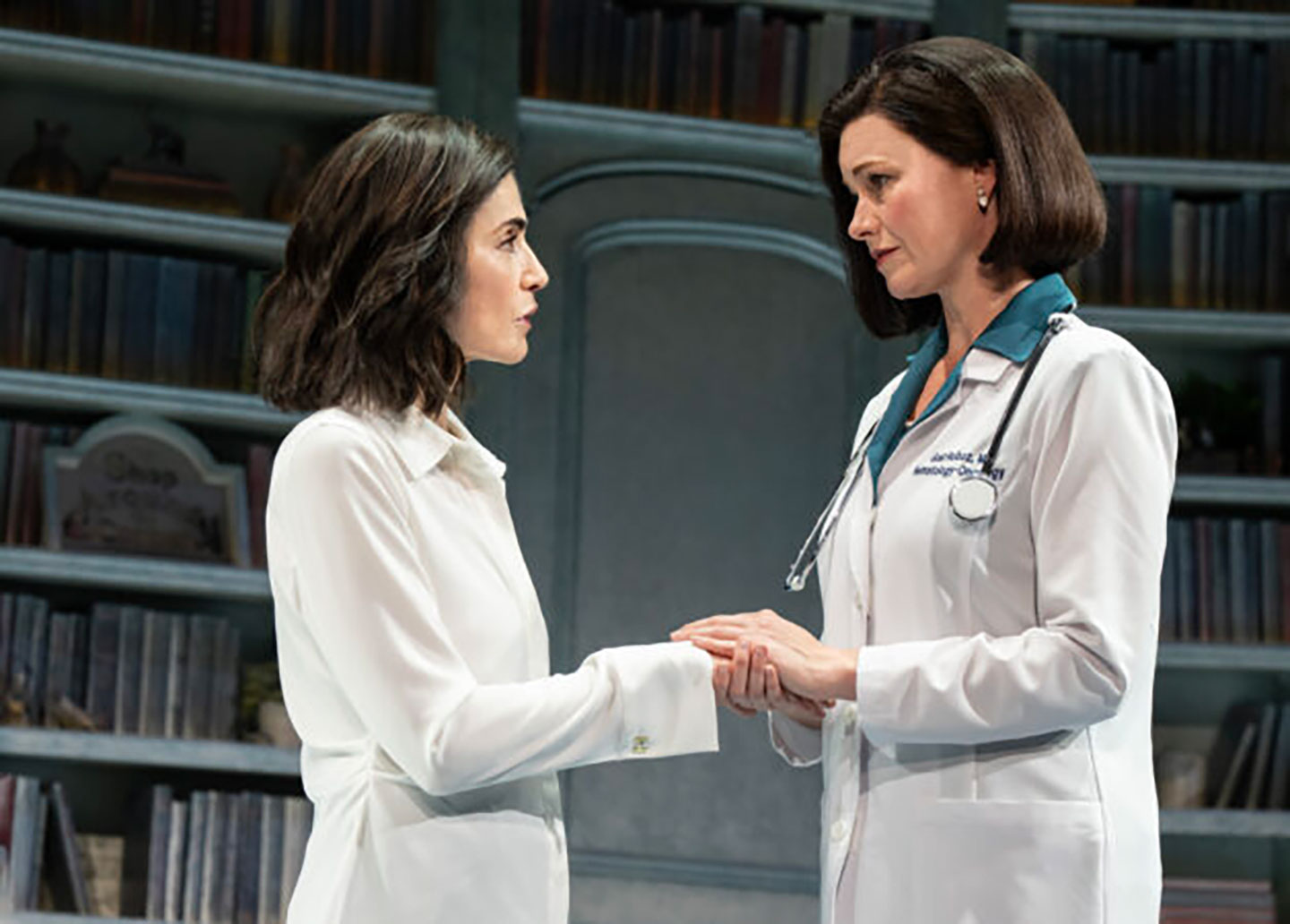
Julianna Margulies and Kate MacCluggage in Left on Tenth (Joan Marcus)
CT: It sounds like a seamless collaboration and a beautiful process for this show.
Itohan, any learnings about yourself or each other that you want to share?
15:51
IE: I think I handle a lot of things with grace. I don't know what that gives, but I feel myself to be very graceful. In this instance I am the youngest person in the room, also the newest person into this room, so there is no room for ego. There is no room for ego or pride or being egotistical about the opportunity I'm given, it doesn't matter. I think in this process, at least for myself, outside of work, I’m constantly thinking about the ego and ridding it from myself, or finding where things spike. I think I was just happy to be witnessing and in the ways that I can provide, I will provide. Then just continue to witness and just sort of glean what works and what doesn't work throughout that process. I don't know if that answers the question or not.
CT: I think it does. Ken, any learnings about yourself or your teammate?
16:45
KB: Thing I have always done is you have to give back. You know, we're artists. How do you give back? People were wonderful to me when I was very young. I was 19 or 20 years old and working in the theater. People helped me and taught me and pushed me and were there for any questions I might have. I always think, we got to pay it forward! That's all I can do. I can make pretty pictures and people pay me, and that's great. But how do I pay it forward?
I think this was just great. Getting a young person in there to be part of this and pay it forward. And hopefully when Ito is my age, you'll be paying it forward. That's what it's all about.
CT: Absolutely. It sounds like you made a great team.
Just for fun, let's play a game: ‘How well do you know your co-lighting designer?’
There are five simple questions, quickfire style.
Let's start with you, Itohan: What is Ken’s favorite tech table snack?
17:58
IE: This wasn't his favorite check table snack, but it is now Cheese-Its.
CT: OK. Ken, what is your favorite?
KB: I hadn't had a Cheese-It in probably 30 years. But put the box on the table and now I’m buying boxes of them. The video department helped devour them too.
CT: Does that mean she got one right so far? Ding, Ding, Ding.
KB: Yeah.
CT: Ken, what is Itohan’s favorite tech table snack?
KB: The Cheetos. I mean, Cheese-Its. It was her favorite. She stuck them on the table, and I ate one. I thought, this is good. So, we nibbled on them. That was it.
CT: Perfect. Ken, what was Itohan’s favorite lighting moment from the play?
18:48
KB: Oh, I have no idea. Honestly, I really don't. We never talked about it. I don't know if I have favorite moments.
The favorite moment is when the lights come up, and let's see if what we did pays off or did we screw it up badly? So, I don't know if she had a favorite.
CT: Itohan, did Ken have a favorite moment from the play?
19:13
IE: I was going to say the same thing. I don't think we had a favorite moment. It was more just like when the lights came up.
But I do remember there was an instance. I was doing some notes at some point and I turned over to look at Ken and his face is just beaming with light. I think Ken was just witnessing everything around him. I just saw him look over and smile and that that was a favorite moment, I think. I think just being in the room and seeing the work that's happening and what we were building. I think that was very special to Ken, which is why he smiled so earnestly. And that made me smile as well.
CT: Nice. Itohan, what is Ken’s favorite place in New York? Is there some place that makes him smile like that?
20:03
IE: Would it be Cosmic Diner? I'm thinking food.

Peter Francis James, Peter Gallagher, Julianna Margulies, and Kate MacCluggage in Left on Tenth (Joan Marcus)
CT: Ken, what is Itohan's favorite place in New York?
IE: I don't know if she liked the Cosmic Diner.
When you do a show, it's about eating. It's about lunch and dinner, right? And in the middle, the lights go on and off. Ito was much more adventuresome in trying to find the new places to go to, whereas I was just very happy to go to the Greek diner on the corner.
Ito loved the sushi. I don't eat it, so some days, they would all just parade off for sushi. And I would go cry in the corner with my Turkey sandwich.
IE: No, you don't.
CT: Ken, with your Turkey sandwich. What is Itohan’s favorite Broadway show of all time?
KB: I don't know if we ever talked about that. I have no idea.
IE: I don't think we did, I also don't know for Ken.
CT: OK, pass.
Itohan, what did you learn about lighting from Ken?
21:11
IE: That he's willing to teach. I don't know if that's a learning thing, but I found that we collaborated a lot in terms of color palettes, and in terms of looks.
Ken would build something and then I would kind of make a sound, like, that's another soldier. And he was like, OK, what do you see in that? I didn’t see it. Why don't you try what you're going to do? There was an openness to me exploring as well. I don't know if that's something to learn or just something that I've noticed.
CT: Ken, what did you learn from Itohan?
21:46
KB: What I learned is that there are different points of view on things. As an artist, they're probably all good. And it was interesting when we would be putting our notes in from the night before, be sitting at the table, and I go, cue 25, I have a note. My next note is cue 20. And she said, I have a note on cue 15. And I never questioned her note. She would just do her note, and I would do my note on cue 20. Then we'd say, I say my next note is cue 25. And she said mine too. I said it should be 3 counts. And she said, Yep, that's what I had down too.
It was nice knowing there was another artist there. Sometimes we were exactly on the same page, and sometimes she was saying things I didn't see, or I was seeing things she didn't see. That made it a better peace.
CT: It sounds like you two are very much in sync. You both win the game! Congratulations.
Any special shoutouts that you'd like to make to your fellow team members on Left on Tenth?
23:00
IE: I would shout out Jeanette Oi-Suk Yew for the projection design. And Jill BC Du Boff for sound.
23:08
KB: McKenna Ebert, who was our assistant lighting designer on the show. She was great and there for us, with whatever needed to be accomplished. She was always a little bit of a step ahead of us.
Jeff Dodson, the Production Electrician who was there making sure it all turned on and turned off. Also the crew - we were having fun with the crew.
It was a nice place to work.
23:39
IE: I will also give a shoutout, to wrap up the lighting team, to our programmer, Jackson Miller, who is super awesome. He was similar to McKenna, in that he was always one step ahead of us in terms of what we were thinking about, and laying it out for us.
CT: To follow up this wonderful Broadway show, are there any other new or upcoming projects that you're working on that you'd like to give us a little teaser of what's to come?
24:09 IE: We're doing a gala event tonight for Perelman Performing Arts Center. It's for the Icons of Culture Festival that happens tonight. We're in the midst of it, so I don't know how much of a shoutout this is, but that's the latest and greatest for me.
I know, Ken’s working on Smash.
24:27
KB: Right. And I go to Prague on Friday and do Beetlejuice. We just opened two new companies in Chicago and have another company in the end of November to open. And there's more Waitress shows, and more Chicago shows, next year. So, there's stuff. It's all lovely and terrific.
CT: I can't wait to see more from you both, and I can't wait to see a future collaboration project. Is there anything else that you want to include?
24:58
KB: I love that you do these things, and you put them out there, especially because you never know who's going to read it. It could be junior high kid someplace and that they might glean something and think this would be fun or learn something and it. It goes along with how do we get the younger generation interested? And how do we keep our art form going forward?
CT: Well, thank you both for your time.
KB: Oh yeah.
IE: Yeah.
CT: Thank you. I know you're both on very tight schedules.
KB: Ito, make magic tonight!
IE: I will do my best, dear!
KB: Yes!
CT: Thank you, all!

Julianna Margulies and Peter Francis James in Left on Tenth (Joan Marcus)
Read more about Itohan Edoloyi, Ken Billington, and the new Broadway play, Left on Tenth:

Itohan Edoloyi
Portfolio website
Ken Billington
KB Associates website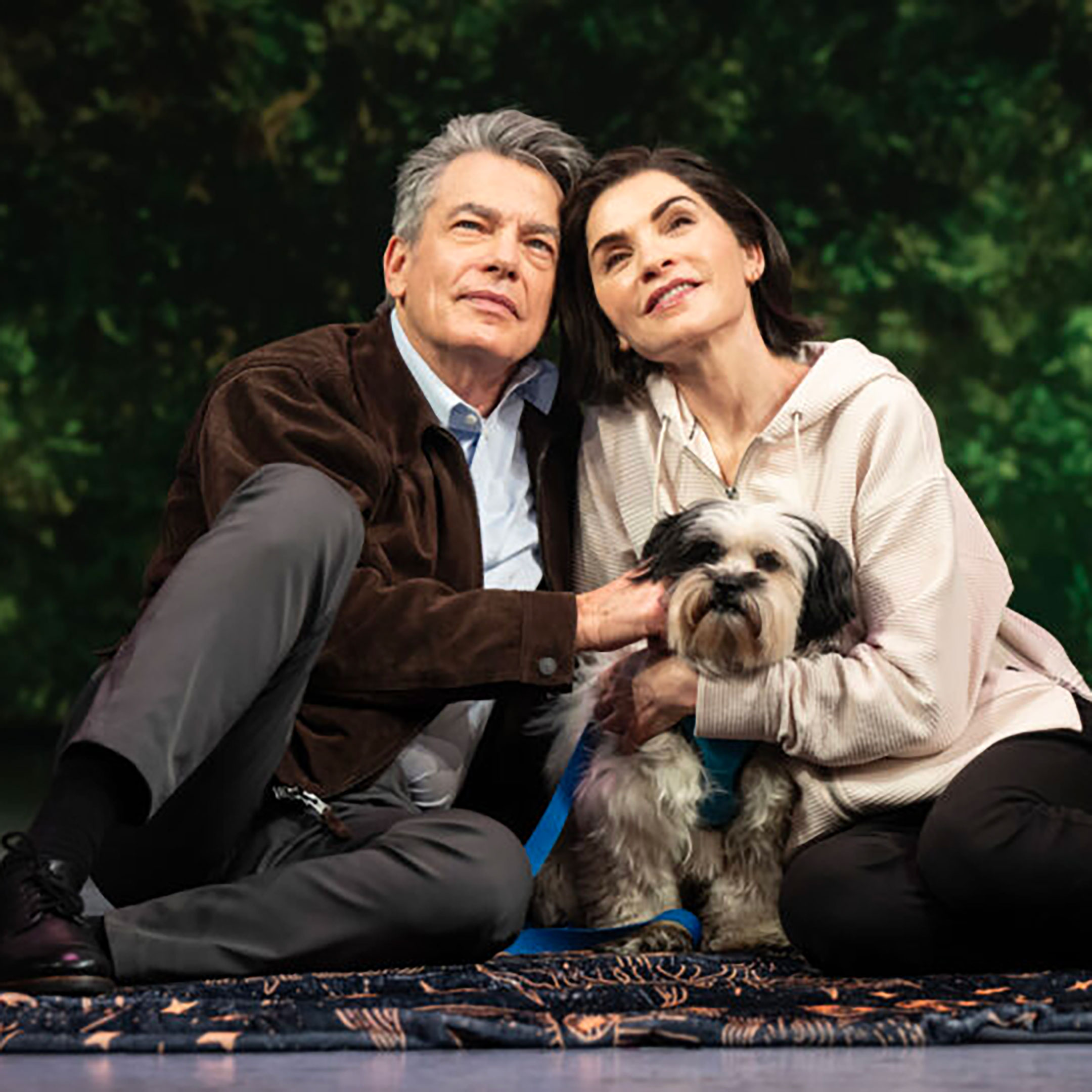
Left on Tenth
Broadway play website
Explore the City Theatrical QolorTOPIX Podcast Series
Listen to this and other light conversations on our podcast page or wherever you get podcasts.
Listen Now
